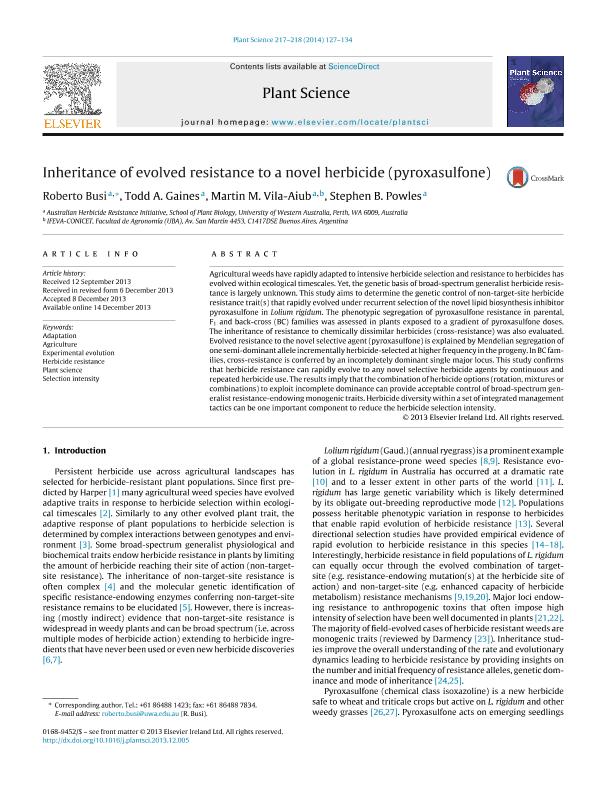Mostrar el registro sencillo del ítem
dc.contributor.author
Busi, Roberto
dc.contributor.author
Gaines, Todd A.
dc.contributor.author
Vila Aiub, Martin Miguel

dc.contributor.author
Powles, Stephen B.
dc.date.available
2016-02-12T19:00:43Z
dc.date.issued
2014-01
dc.identifier.citation
Busi, Roberto; Gaines, Todd A.; Vila Aiub, Martin Miguel; Powles, Stephen B.; Inheritance of evolved resistance to a novel herbicide (pyroxasulfone); Elsevier Ireland; Plant Science; 217-218; 1-2014; 127-134
dc.identifier.issn
0168-9452
dc.identifier.uri
http://hdl.handle.net/11336/4178
dc.description.abstract
Agricultural weeds have rapidly adapted to intensive herbicide selection and resistance to herbicides has evolved within ecological timescales. Yet, the genetic basis of broad-spectrum generalist herbicide resistance is largely unknown. This study aims to determine the genetic control of non-target-site herbicide resistance trait(s) that rapidly evolved under recurrent selection of the novel lipid biosynthesis inhibitor pyroxasulfone in Lolium rigidum. The phenotypic segregation of pyroxasulfone resistance in parental, F1 and back-cross (BC) families was assessed in plants exposed to a gradient of pyroxasulfone doses. The inheritance of resistance to chemically dissimilar herbicides (cross-resistance) was also evaluated. Evolved resistance to the novel selective agent (pyroxasulfone) is explained by Mendelian segregation of one semi-dominant allele incrementally herbicide-selected at higher frequency in the progeny. In BC families, cross-resistance is conferred by an incompletely dominant single major locus. This study confirms that herbicide resistance can rapidly evolve to any novel selective herbicide agents by continuous and repeated herbicide use. The results imply that the combination of herbicide options (rotation, mixtures or combinations) to exploit incomplete dominance can provide acceptable control of broad-spectrum generalist resistance-endowing monogenic traits. Herbicide diversity within a set of integrated management tactics can be one important component to reduce the herbicide selection intensity.
dc.format
application/pdf
dc.language.iso
eng
dc.publisher
Elsevier Ireland

dc.rights
info:eu-repo/semantics/openAccess
dc.rights.uri
https://creativecommons.org/licenses/by-nc-nd/2.5/ar/
dc.subject
Adaptation
dc.subject
Agriculture
dc.subject
Experimenal Evolution
dc.subject
Herbicide Resistance
dc.subject.classification
Genética y Herencia

dc.subject.classification
Ciencias Biológicas

dc.subject.classification
CIENCIAS NATURALES Y EXACTAS

dc.subject.classification
Agronomía, reproducción y protección de plantas

dc.subject.classification
Agricultura, Silvicultura y Pesca

dc.subject.classification
CIENCIAS AGRÍCOLAS

dc.title
Inheritance of evolved resistance to a novel herbicide (pyroxasulfone)
dc.type
info:eu-repo/semantics/article
dc.type
info:ar-repo/semantics/artículo
dc.type
info:eu-repo/semantics/publishedVersion
dc.date.updated
2016-03-30 10:35:44.97925-03
dc.journal.volume
217-218
dc.journal.pagination
127-134
dc.journal.pais
Irlanda

dc.journal.ciudad
Shannon
dc.description.fil
Fil: Busi, Roberto. University Of Western Australia. School of Plant Biology. Australian Herbicide Resistance Initiative; Australia
dc.description.fil
Fil: Gaines, Todd A.. University Of Western Australia. School of Plant Biology. Australian Herbicide Resistance Initiative; Australia
dc.description.fil
Fil: Vila Aiub, Martin Miguel. Consejo Nacional de Investigaciones Científicas y Técnicas. Oficina de Coordinación Administrativa Parque Centenario. Instituto de Investigaciones Fisiológicas y Ecológicas Vinculadas a la Agricultura; Argentina
dc.description.fil
Fil: Powles, Stephen B.. University Of Western Australia. School of Plant Biology. Australian Herbicide Resistance Initiative; Australia
dc.journal.title
Plant Science

dc.relation.alternativeid
info:eu-repo/semantics/altIdentifier/url/http://www.sciencedirect.com/science/article/pii/S0168945213002665
dc.relation.alternativeid
info:eu-repo/semantics/altIdentifier/doi/http://dx.doi.org/10.1016/j.plantsci.2013.12.005
dc.relation.alternativeid
info:eu-repo/semantics/altIdentifier/issn/0168-9452
Archivos asociados
